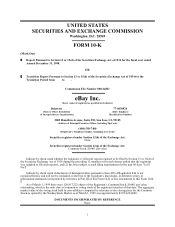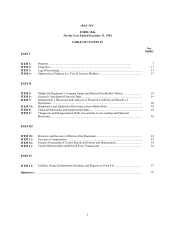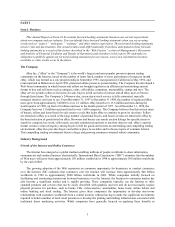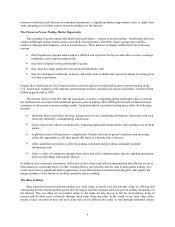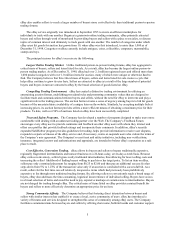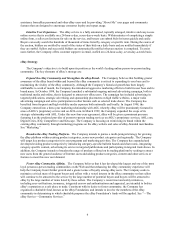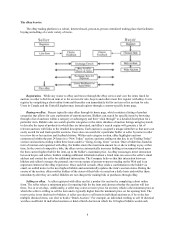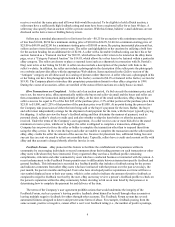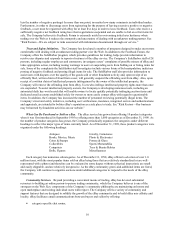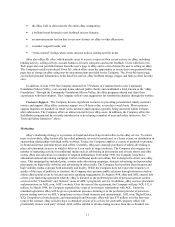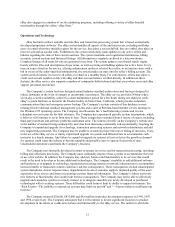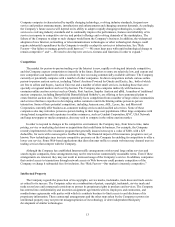eBay 1998 Annual Report Download - page 3
Download and view the complete annual report
Please find page 3 of the 1998 eBay annual report below. You can navigate through the pages in the report by either clicking on the pages listed below, or by using the keyword search tool below to find specific information within the annual report.
3
PART I
Item 1: Business
This Annual Report on Form 10-K contains forward-looking statements based on our current expectations
about our company and our industry. You can identify these forward-looking statements when you see us using
words such as “expect,” “anticipate,” “estimate” and other similar expressions. These forward-looking statements
involve risks and uncertainties. Our actual results could differ materially from those anticipated in these forward-
looking statements as a result of the factors described in the “Risk Factors” section of Management’s Discussion
and Analysis of Financial Condition and Results of Operations and elsewhere in this report. We undertake no
obligation to publicly update any forward-looking statements for any reason, even if new information becomes
available or other events occur in the future.
The Company
eBay Inc. (“eBay” or the “Company”) is the world’ s largest and most popular person-to-person trading
community on the Internet, based on the number of items listed, number of users and minutes of usage per month.
eBay, which was formed as a sole proprietorship in September 1995, incorporated in California in May 1996, and
reincorporated in Delaware in April 1998, pioneered online person-to-person trading. The Company has developed a
Web-based community in which buyers and sellers are brought together in an efficient and entertaining auction
format to buy and sell items such as antiques, coins, collectibles, computers, memorabilia, stamps and toys. The
eBay service permits sellers to list items for sale, buyers to bid on items of interest and all eBay users to browse
through listed items. The Company’ s 24-hour-a-day, seven-day-a-week service is fully automated, topically
arranged, intuitive and easy to use. From December 31, 1997 to December 31 1998, the number of registered eBay
users grew from approximately 340,000 to over 2.1 million. eBay hosted over 13.6 million auctions during the
fourth quarter of 1998, up from 2.0 million auctions in the fourth quarter of 1997. As of December 31, 1998, the
Company had over 1.0 million auctions listed in over 1,000 categories. The Company believes that this critical mass
of buyers, sellers and items listed for sale creates a cycle that helps eBay to continue to grow its user base. Sellers
are attracted to eBay as a result of the large number of potential buyers, and buyers in turn are attracted to eBay by
the broad selection of goods listed on eBay. Browsers and buyers can search auction listings for specific items or
search by category, key word, seller name, recently commenced auctions or auctions about to end. eBay’ s auction
format creates a sense of urgency among buyers to bid for goods and creates an entertaining and compelling trading
environment. eBay also provides buyers and sellers a place to socialize and to discuss topics of common interest.
This compelling trading environment fosters a large and growing commerce-oriented online community.
Industry Background
Growth of the Internet and Online Commerce
The Internet has emerged as a global medium enabling millions of people worldwide to share information,
communicate and conduct business electronically. International Data Corporation (“IDC”) estimates that the number
of Web users will grow from approximately 150 million worldwide in 1998 to approximately 500 million worldwide
by the end of 2003.
The growing adoption of the Web represents an enormous opportunity for businesses to conduct commerce
over the Internet. IDC estimates that commerce over the Internet will increase from approximately $40 billion
worldwide in 1998 to approximately $900 billion worldwide in 2003. While companies initially focused on
facilitating and conducting transactions between businesses over the Internet, the business-to-consumer market has
also become a significant market and is rapidly growing. These companies typically use the Internet to offer
standard products and services that can be easily described with graphics and text and do not necessarily require
physical presence for purchase, such as books, CDs, videocassettes, automobiles, home loans, airline tickets and
online banking and stock trading. The Internet gives these companies the opportunity to develop one-to-one
relationships with customers worldwide from a central location without having to make the significant investments
required to build a number of local retail presences or develop the printing and mailing infrastructure associated with
traditional direct marketing activities. While companies have generally focused on applying these benefits in

